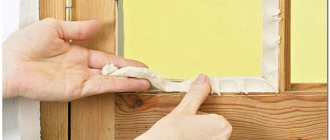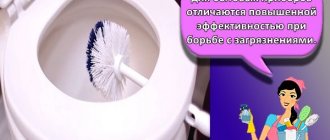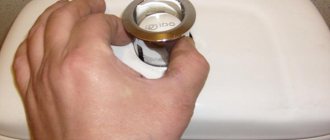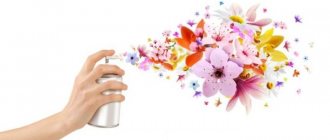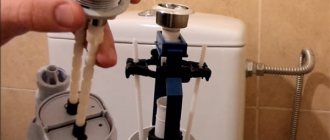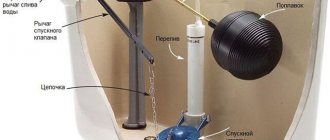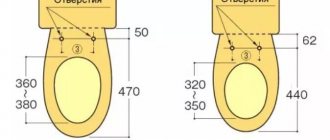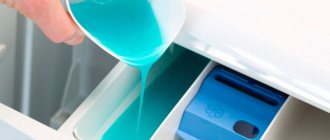Handle and nozzle (head) of a toilet brush
Ruff (kvach) is a brush made of artificial fibers or plates on a half-meter handle. The set usually includes a glass stand, and sometimes a mount for installation on the wall. The design of the brush head and its handle can vary greatly depending on the specific model. Here are the designs of brushes that can be found on sale:
Straight handle and round head
The photo shows the most common brushes with plastic handles and heads made of artificial bristles. The option with a slightly curved handle is more practical , but these are still rather “clumsy” tools, with the help of which it is impossible to properly clean hard-to-reach places.
Straight handle and oblong head with double-sided bristles
A more sophisticated brush made from the same materials. Equipped with double-sided bristles , which makes it easy to clean even the edge of the toilet bowl from dirt. The head is slightly curved for ease of use. But it has the same drawback as the first option: bristles, which are difficult to clean from dirt. This means that the brush will have to be changed often or better washed.
Double-sided brush with silicone head
Suitable for cleaning hard-to-reach places. The cleaning surface does not become clogged.
D-shaped brush head
The D-shaped head of the brush reaches all the hidden corners. The brush head is flexible because it is made of silicone. The design of the head and the material of the “ pimples ” make it easy to wash the brush under running water . Curved metal handle with plastic holder and oblong double-sided cleaning surface.
Silicone spiral head and straight but flexible handle
Another model of a non-clogging head. The handle is straight, but made of elastic material , so it bends easily when you need to reach the rim and other hard-to-reach places on the toilet. Easy to wash after use.
Semicircular flat brush with magnetic holder
Original head shape and straight handle. Convenient model for both cleaning and storage.
Flat brush, curved in the shape of a question
This clever design allows you to effectively combat pollution. The brush is flexible, so it will reach everywhere.
Flat brush with straight handle
Not the most convenient option for cleaning. But it looks stylish. Compact.
A budget version of a flat brush with a Soviet design
Not very convenient to use. No stand or holder.
Another model familiar from Soviet times.
Disposable brush
Brush with a disposable fabric nozzle.
Hygienic option. Be sure to throw away the replacement part after use.
Collapsible brush with a set of nozzles
Double-sided model with flexible curved handle
Cone-shaped silicone brush with metal handle
The tool has a very flexible head . The photo shows how to use the device. Does not clog, easy to rinse. Suitable not only for washing, but also for cleaning the toilet .
Toilet brush with a nozzle without bristles
A very hygienic option. Moreover, the brush is reusable .
Accessory requirements
When you are thinking about buying a brush, you need to think about how well it will meet your requirements and certain criteria. There is a small list of characteristics that any toilet brush must meet.
- The cleaning element must be made of a synthetic material with sufficient rigidity. With its help, it will be much easier to remove dirt.
- The handle is preferably smooth in texture, long enough, and made of durable material. It should be comfortable to hold, but at the same time strong bends are not allowed.
- Preference should be given to collapsible models, since cleaning them in this case will be much easier.
Terms of use
Photo of a designer brush
For some this may seem funny. In principle, you have every right to laugh at the instructions for a toilet accessory. However, you should have a clear understanding of how to use a brush. This will be useful to you yourself, and will also allow you to correctly interpret to your child what this thing is, what it is for, and how to use it correctly.
- The first thing you need to do is grab the handle comfortably and with a firm grip. Do not hold the toilet brush too close to the cleaning head. Actually, almost every model has a specific section of the handle intended for holding by hand.
- Using progressive, gentle movements, begin to remove dirt. You should first dip the brush in water and wet it, after which removal will be easier. In order to simultaneously get rid of excess odors and disinfect the toilet, add a little detergent and cleaner to the toilet.
- Drain the toilet using the flush cistern, while placing a brush under the pressure of the water. This will remove any remaining dirt from it and clean it.
- After rinsing the toilet brush, shake it off a little, after which you can safely put it back in its rightful place.
There are a couple more very useful tips that you should definitely follow and that it is extremely important to teach your children
- When you start cleaning after your business using a toilet brush, do not make any sudden movements. This may result in splashes that fly towards you, onto your clothing, or even onto your skin. We think you shouldn’t imagine what sensations you will experience. Don't take risks, so work the tool smoothly.
- Shake the accessory while it is still inside the toilet by hitting the walls directly next to the water in the plumbing. Many people begin to shake off, hitting the end of the handle on the toilet seat. This causes splashes to fly in different directions, onto the toilet seat itself, onto the toilet lid, onto the wallpaper, and so on.
Storage and care
Interestingly, many people prefer glass and wall-mounted models. However, from the point of view of safety and hygiene, this is the most wrong decision.
But the recommended option is suspended. But even here it is advisable to comply with certain conditions:
- Your toilet brush should not be in contact with the floor;
- The accessory should not come into contact with the wall;
- Be sure to place a container underneath it that is wide enough to allow all the water to drain into it.
Now regarding care. Please note that the toilet brush will have to be washed periodically. The more often this happens, the safer it will be to use. Essentially, there are two proven, effective cleaning methods.
- Dip the cleaning head into any liquid intended for disinfection, thereby getting rid of all kinds of bacteria and infections.
- Wet the toilet brush using white vinegar. Just be careful not to get the liquid on your skin, especially your eyes.
When the disinfection procedure is completed, lower the cleaning head into the toilet, press the water release button, thereby washing the instrument. After this, you can safely put the accessory in place.
It is recommended to hold such events at least once a month. But this is provided that you or your household do not have an intestinal infection. If there are any, then the brush should be cleaned weekly.
As you can see, a brush is far from the simplest accessory for toilets. It has its own characteristics, its own recommendations for use and care.
Despite a number of recommendations for use and selection, you should purchase not only on the basis of safety, so to speak. The modern range of brushes is so huge that all your personal wishes can be combined in one model, and at the same time the tool will fully comply with even the most stringent requirements for hygiene and reliability.
Functions of a toilet brush
This is interesting: in Europe and the USA, many people do not even know what a brush of such an unusual design is intended for. And all because the flushing system in foreign toilets is significantly different from the domestic one: water flows there constantly , and when flushed, in a large flow and not from the tank, completely removing traces of visiting the toilet. And with us - in portions and in small quantities. Therefore, without “kvacha” it is difficult to maintain cleanliness.
In addition to the cleaning function , with regular use the brush prevents the formation of limescale. This avoids the proliferation of many pathogenic microorganisms.
Vinegar and soda
Table vinegar, which every housewife has, eliminates the smell and removes the brush quite well. You can add soda and pour vinegar directly into the thicket where the brush is located. A chemical reaction will occur and foam will be released. Leave the brush for 40 minutes and clean it by rinsing with warm water.
Vinegar does a good job of cleaning limescale deposits caused by excessively hard tap water. Removes rust if diluted with water and poured into the tank. You need approximately 1 cup of vinegar.
Toilet brush handle material
The plumbing market is replete with budget plastic products. But if you wish, you can buy a brush with a ceramic or metal handle . This part of the accessory is also made of stainless steel, silicone, chromed metal and even wood.
- The metal is strong and durable, easy to clean .
- strong>The advantage of cheap plastic is that you don’t mind throwing away and buying a new one. Perhaps from a hygiene point of view this approach is preferable. On the other hand, you can take care of the environment and buy a durable model . This is a matter of taste and habit. For some it is easier to wash the old brush, and for others it is easier to buy a new one.
- Silicone perfectly repels water and dirt , maintaining an attractive appearance for a long time. Silicone handles are flexible and durable.
- A wooden handle doesn't have any special advantages other than being comfortable to hold.
The price of the accessory depends on the quality and reliability of the material.
Cleaners: unnecessary thing or irreplaceable accessory?
Design features
A toilet brush is an essential attribute of any restroom. It does not stand out in any way among other accessories of the sanitary room, but plays a very important role in maintaining the ideal sanitary condition and cleanliness of the toilet (read also the article “Connecting a toilet: how to properly connect the device to the apartment’s utility networks”).
Even if you don't care about how to clean up traces left after your visit to the restroom, you should take care of your health. After all, failure to comply with hygiene requirements leads to rapid proliferation of bacteria, which can be the causative agents of very dangerous diseases.
Note! The design of toilets installed in European and New World countries differs from those used in our country. They drain continuously (water flows) and traces of feces are washed off automatically. Therefore, Europeans and Americans do not even know the correct name of this item.
The photo shows a simple brush for cleaning a toilet bowl.
Externally, a toilet brush is a brush made of synthetic fiber, attached to a durable handle of short length (usually not exceeding 50 cm). Most often it is placed in a special glass, which also serves as a stand.
There are a huge number of brushes.
They are made from various materials:
- of stainless steel;
- chromium;
- ceramics;
- plastic;
- silicone.
Naturally, the price of the accessory directly depends on this. An ordinary plastic device costs mere pennies, but a high-quality floor-mounted metal toilet brush with a stand can cost you a very decent amount of money.
A metal brush is more expensive, but it is stronger and more durable.
On the other hand, in order not to urgently figure out how to clean the toilet if the brush breaks, it is better to focus not on the cost, but on the quality of the products. The same metal will serve you for many years, maintaining its attractive appearance and consumer properties.
As for design features, there are several options. You can learn about each of them from the table.
| View | Peculiarities |
| Glass | In this case, the brush is installed in a special glass, which is located on the floor. The disadvantage of this solution is that the brush is always in dirty water, which is an ideal environment for the proliferation of pathogenic bacteria. |
| Wall | The brush is placed in the same glass, but the latter does not stand on the floor, but is fixed on the wall. The difference here is purely external. The disadvantages are the same as in the previous case. |
| Suspension | This design is optimal from a sanitation point of view. The brush is hung on a special hook, and the container into which the flowing water drips is placed under it on the floor. |
The accessory can be placed on the floor or attached to the wall
There are also special brushes that differ from the standard and familiar designs.
These include:
- brushes with double brush;
- devices with a toilet paper holder and so on.
Note! Design versions of these devices can also be found on sale. For example, with handles in the shape of animals or with portraits of political figures. The choice depends only on your personal preferences and the style of design of the plumbing facilities.
Tips for choosing
You can choose any appearance of the toilet brush.
However, to make using the purchased brush as convenient as possible, it is advisable to pay attention to the following features:
- The brush itself should be made from hard artificial fibers. Bristles that are too soft will not be able to effectively remove dirt from the surface of the toilet.
- The handle should be strong, smooth and long enough. Here you need to focus on ease of use and durability. Plastic, for example, can break if you apply too much force to the brush holder while trying to remove dried stains.
- It is better to buy dismountable models, as they are easier to maintain: disassemble, wash and disinfect.
Buy brushes with comfortable handles
Material of the nozzle (head) of the toilet brush
- Choose an accessory with hard synthetic bristles. It cleans the inner surface of the toilet bowl better, lasts longer and does not deform. Soft fibers simply cannot cope with dirt. Natural bristles are also not suitable.
- In addition to the usual bristle brush, there are models where instead of artificial fibers, blade-like silicone plates twisted in a spiral are used. This option is much more hygienic, since the soft material of the plates perfectly and gently cleans the toilet and is then easy to clean. A traditional bristle brush sometimes has to be thrown away due to severe contamination, but this model can simply be rinsed.
- Another variety is brushes with a textured surface made of silicone . Brushes with a head made of this material are easy to wash after use, they dry very quickly.
- Two-level bristles provide better cleaning . Pay attention to the distance between the bristles: if it is wide enough, dirt will not be trapped between the fibers and can quickly flow into the water.
- There are brushes on sale with a removable and permanently attached head . A removable cleaning brush is more practical . These brushes are more convenient to clean, and if the bristles wear out, they can be replaced without throwing away the handle. Among disposable models there are fabric attachments (as in the photo above). Collapsible models , in general, are more convenient to use and maintain. They are easier to wash, disinfect, and dry. You can find brushes with an additional brush on sale.
How to choose a toilet brush and keep it clean
A toilet brush looks like a brush made of artificial bristles, which are shaped like a sphere and are attached to a handle 50–70 cm long. This accessory is used to keep plumbing fixtures clean. It is used both immediately after visiting the toilet and during regular cleaning of the toilet. The brush is sold complete with a special stand, shaped like a bowl, into which it is inserted.
This accessory is an integral attribute of every toilet room; it is impossible to imagine high-quality cleaning of plumbing without its use. A brush is difficult to find in Western countries, where toilets have a slightly different design that does not allow dirt and bacteria to linger on their surface.
The brush allows you to clean the toilet until white without getting your own hands dirty. There are many different models of brushes available in stores, differing in the material from which they are made and functional features.
Brushes that allow you to clean the toilet can be divided into several types.
When planning to purchase a brush to clean the toilet, you should pay attention to a number of important features:
- Ergonomics of the accessory – it should fit comfortably in the hand, the handle should not be too long or, conversely, too short. The accessory should not bend; its handle should have a smooth surface.
- The brush head must be made of artificial material of sufficient rigidity, otherwise it will not be able to perform its main function.
- Special attention is paid to accessories that can be disassembled into parts. This makes it convenient to wash them and disinfect all parts of the structure.
- The style of the brush should be combined with other interior items of the toilet room and not look like an alien element there.
To ensure the hygienic cleanliness of the toilet, it is not enough to flush the water thoroughly; you must clean its surface with a special brush. Proper use allows you to remove not only biological contaminants, but also rust.
A toilet brush can contain several thousand varieties of bacteria and microbes. Not only will it lose its pleasant appearance, the brush will acquire a foreign odor and pose a potential threat to the health of all household members. This is why weekly cleaning of not only the toilet itself, but also the brush is so important.
How can you easily clean a toilet brush without much time or effort?
Simply cleaning the brush using a soap solution will not be enough to remove all bacteria and germs from it.
Therefore, it is important to periodically disinfect this accessory using the following substances:
Whiteness, “Toilet duckling”, “Cilit Bang”, “Domestos” and other cleaning substances containing chlorine. It is imperative to use rubber gloves when working with such products to prevent skin burns. Vinegar essence is an excellent disinfectant.
It is important to keep it out of the reach of children, and when using it, wear protective gloves and try not to inhale its pungent odor. Boric acid, hydrogen peroxide and manganese work well against bacteria. The following composition disinfects a toilet brush well: baking soda, vinegar and boiling water. You need to soak the accessory in this product for 1 hour.
The toilet brush needs to be washed regularly, this is the only way to keep it clean and protect it from the spread of germs. However, improper storage of it can lead to the fact that you will have to wash the entire toilet room, including its walls and floor.
To prevent such a situation from occurring, you need to carefully consider the location of this useful accessory:
it should not touch the surface of the floor and walls; if the brush is hanging, there must be a container under it to collect liquid; the brush should be in close proximity to the toilet so that water does not drip from this accessory onto the floor while it is being carried to the storage location; It is important to explain the rules for using a brush to all family members so that you do not have to organize cleaning of the entire bathroom.
Whatever toilet accessory you choose, it is important to properly organize its storage location and thoroughly and regularly clean it of dirt. In addition, it is important to throw away your old brush every 6 months and purchase a new accessory.
If these rules are followed, the brush will perform its functions well and will not cause health problems.
Brush attachment type
Floor-standing
The traditional version, consisting of a flask and a brush itself. Usually placed near the toilet. Mobile design.
Sometimes this option is also glass , but this is not entirely correct, since there are models with stands of a different configuration. Among them are original products:
This option is the least hygienic . The brush, which is by no means sterile, is stored in a humid environment favorable for the proliferation of various microorganisms, fungus and mold. Therefore, if you decide to buy such a unit, add disinfectant liquid to the glass every time you use the brush. The brush itself also needs to be washed before placing it in the flask. There are more spacious flasks in which the brush seems to hang without touching the bottom . This is the best variant.
Wall and hanging
Wall brush stands have a special mount that is mounted on the wall. This variety has the same disadvantages in terms of hygiene as the previous floor design - the instrument is located in a flask without ventilation . Placing it across the bowl, as shown in the photo, is not entirely hygienic, because the drops will simply flow onto the floor.
Another interesting model for the wall:
A type of wall brushes is floor-suspended structures .
Floor-suspended design.
As the name suggests, the brush is hung by the handle on a special mount. From a hygiene point of view, this is the most acceptable option (except for disposable ones). The brush is suspended, ventilated , and the water flows from it into a glass placed directly under the brush. Just be sure to rinse the brush after use. The container also needs to be washed periodically. After the brush has dried, it can be placed in a flask.
In principle, you can dry any brush this way, but it is much more aesthetically pleasing when the set includes a “original” glass or other container.
Combined
In this model, both the brush and the plunger are suspended. They are ventilated and the water flows not onto the floor, but into the bowl.
There are combined floor holders for a brush and a plunger, stands containing a holder for toilet paper, a flask for a brush, a shelf for an air freshener, etc. Sometimes the kit even includes a newspaper holder.
Popular models with a built-in detergent holder:
Here is another option for a multifunctional container (trash can plus holder for a brush):
Multifunctional holders save space in the toilet and help keep the necessary equipment clean and tidy.
Wall combination holders are also available.
The traditional multifunctional model for a brush and toilet paper holder looks like a high hanging stand with a bottle for a brush and a roll holder:
Types of brushes
Design features may vary.
Glass brush
A glass brush is placed in a bowl or glass. Does not require special placement; it is installed next to the toilet. The main disadvantage is the proliferation of pathogenic microbes in thickets where there is constant humidity and dampness. It is necessary to regularly disinfect and clean the toilet brush.
Wall brush
The place of fastening is the wall, but it will still be placed in the same glass. The disadvantages are the same as with a glass. The main advantage is ease of cleaning; it is most suitable for installation with wall-hung toilets .
Hanging brush
The entire structure is placed on a special hook or installed on the floor. There is a container at the bottom where water flows, preventing it from getting onto the floor. Less favorable conditions for the proliferation of pathogenic microbes are created. There are brushes with standard, familiar brushes, and there are special ones with double bristles with a toilet paper holder, and the like.
There are original brushes with designer gadgets in the form of a container in the shape of sea water with shells, handles that imitate animals, brushes with portraits of political party leaders. You can choose to suit every taste and preference, thus decorating your everyday life.
cool toilet brush ceramic brush
Convenience
Ease of use is an important factor when choosing a brush. Take the instrument in your hand and hold it. If you are comfortable, then you can clean the toilet bowl without any extra effort.
Length and shape of the brush handle
Models with a long handle are much more convenient to use . The handle should be made of a smooth, durable material, without burrs or roughness. It should not bend too much or break when pressed.
To reach the most secluded corners, the brush should have a curved shape:
Quality of brush head bristles
Stiff, sparse bristles with multi-level bristles clean the toilet well and are easy to rinse under running water. Silicone models provide a higher level of hygiene.
If you choose the right one, this accessory will last for many years.
Toilet brush mounting type
This parameter depends entirely on your preferences. Some people find it more convenient to use a floor structure, while others prefer a wall structure. The floor brush is simpler - no need to drill into the wall. And it's mobile, which is important when cleaning multiple toilets.
List of rules for using the toilet
There are no single universal rules for using a toilet; there is only a list of recommendations that directly depend on the specific type of toilet installed in a particular toilet, as well as the type of flush control.
The most common types of toilets in our country are:
- Floor-standing with toilet seat.
- Hanging with a toilet seat.
- Chalice of Genoa.
The first type is a regular toilet, located in almost every apartment, attached to the floor with bolts and having a lid and a toilet seat.
The second type is a regular toilet, but it is bolted not to the floor, but to the wall of the toilet and has a seat and a lid.
The Genoa bowl is an unusual anti-vandal toilet, the bowl of which is located at floor level. You need to relieve yourself while sitting on your haunches, like in a rural toilet like a toilet.
There are 2 main types of drain control:
With a push-button control type, liquid is drained from the tank by pressing a button or key into the stock, after which a spring actuates the drain valve.
With the lever type of control, the liquid is drained after squeezing a special lever or pulling the drive cord, which pulls the plug out of the drain hole.
If a regular or wall-hung toilet is installed in the bathroom, the following rules should be observed when using it:
Before sitting on the toilet, you must lower your pants (shorts, leggings, etc.) and panties (tights) to your knees. If a girl is wearing a dress (skirt), then it needs to be pulled up so that its lower edge is at waist level. If the toilet seat cover is lowered, it should be lifted and supported against the drain tank. If the toilet seat is raised, it must be released. It is necessary to sit on the toilet so that your back is facing the cistern, and your legs, slightly bent at the knees, rest lightly on the floor
It is important to spread your legs so that your butt does not fall into the bowl. When performing an act of defecation, it is prohibited to fidget, twist to the sides or jump on the toilet seat. It is strictly forbidden to climb with your feet on the toilet and relieve yourself while squatting, resting your feet on the edges of the bowl. After completing the act of defecation, you need to stand up or raise one hip and wipe yourself with toilet paper. Then the soiled paper should be folded in half and thrown into a special bucket or, if there is none, into the toilet. Finally, you need to stand up, release the lid, press the drain control button all the way and slowly release it
If the flushing system is lever-based, then you need to gently press the lever or smoothly pull out the drive cord as far as it will go and release it after emptying the tank. When passing urine while standing, boys should lift the toilet seat and lid before urinating and release them before flushing.
If a Genoa Bowl is installed in the bathroom, you must follow the following rules:
Before performing natural needs, you should remove all items from your trouser pockets to avoid them falling into the drain hole. Next, you need to lower your trousers and underpants to your knees or pull up your skirt to your waist. After this, you need to squat over the bowl, and it is important that your butt is located directly above the drain hole. During bowel movements, boys should hold the genital organ with their hand so as not to accidentally wet their pants. During the act of defecation, it is strictly forbidden to bend too much backwards or sway to the sides, since due to unnecessary movements you can lose your balance and literally sit in a puddle. After relieving yourself, you should wipe yourself off with toilet paper. Before flushing, you should step aside, otherwise there is a risk of accidentally splashing your clothes.
Regardless of what type of toilet is installed in your toilet, you should remember that this device is not intended for washing feet, watering pets or using it for other household purposes.
Toilet brush design
On sale you can find very beautiful sets of holders for brushes and dispensers. Made in the same style, they will serve as a decoration for the toilet. for brushes very elegant A metal and plastic handle will harmonize with a modern design, a ceramic one with a classic one. Wooden will complement the rustic style. But the material of the handle is not that important. What matters is how it looks as a whole and how well it harmonizes with the interior.
There are animalistic models in the form of funny animals, plant motifs, etc.
But don’t forget that when choosing a brush, the main thing is its functionality and hygiene.
What types of brushes are there?
According to the methods of arrangement, toilet brushes are divided into three types:
- Floor-standing. The stand is made in the shape of a glass. Can be placed in any convenient place in the bathroom.
- Wall-mounted. Equipped with a special wall mount.
- Hanging. The brush is hung from a special mount by the handle.
While our toilet brush is an indispensable tool for maintaining cleanliness, European and American housewives have no idea what it looks like. How to use it and why it is needed at all. It's all about differences in toilet designs. In European and American toilets, flushing water constantly washes away traces of human visits. And in post-Soviet designs, drainage is carried out in portions. Therefore, American and European housewives do not need to use a brush.
Source
Rules for using a toilet brush
Everyone knows how to use a brush. And mostly they make mistakes. Here are some useful tips:
- Take the brush approximately in the middle of the handle , not too close to the head so as not to get dirty, and not too far away so that it slips out of your hands.
- Wet the brush and add a few drops of disinfectant /cleaner. It is also added to the toilet.
- Try to make smooth movements to avoid splashes.
- When finished , flush the water once, while using a brush to help wash away the dirt .
- Drain the water again, this time to wash the brush .
- Shake the brush very while it is inside. Try not to let the splashes fly out.
- Return the accessory to its place.
Floor and wall brush designs require more frequent replacement . Keep the brush hanging and it will last longer. After all, this is how it is ventilated. During operation, all this pathogenic microflora can enter the skin or mucous membranes through the respiratory tract.
How to use a hanging brush:
- The brush is hung so that it does not touch the walls or floor .
- A wide water catcher is installed under the brush .
Regardless of which model you purchased, the entire set must be disinfected periodically (at least once a month). You need to wash both the bowl and the brush. Do not forget to wear gloves and a mask if you use aggressive detergents (chlorine-containing solutions, vinegar). For cleaning, you can also use hydrogen peroxide, potassium permanganate, and boric acid.
The cleaning product is simply poured into a bowl and the brush is soaked in it for a while. Then both items are dried.
The article was written for the site.
Tags:Restroom, Toilet
Household chemicals
Pour “Domestos” or “Silit” into the glass where the brush is located, which will also help to clean the brush well. Wiggle it around, thoroughly breaking up the hard deposits.
Advice. Take Domestos in a black bottle for this purpose. Cleans everything perfectly, even heavy dirt.
Pour in new detergent and soak the brush for two or three hours. Be sure to rinse afterwards with clean running water. During soaking, it is better to take this brush to the balcony or other place so as not to breathe in harmful fumes.
When working with household chemicals, do not forget about rubber gloves and safety glasses.
To allow water to drain from the brush, if you are not using a hanging brush, clamp it between the toilet lid and leave it in that position to allow the water to drain.
Sunlight is the best disinfectant.
The sun's rays kill known bacteria and viruses and have a detrimental effect on worm eggs, which are not exposed to disinfectants due to their dense outer shell. Place it in the open rays of the sun for 10 - 15 minutes
How to choose correctly
It should be remembered that a toilet brush is not something that is used for years or even decades. It needs to be changed periodically. To ensure that your toilet accessory serves you well and for a long time, pay attention to the selection recommendations below.
- Pay attention to the ergonomics of the item. Hold it in your hands. Make sure that the handle does not bend too much and does not slip out of your palms.
- Give preference to brushes with stiff bristles. Soft fibers will not cope with dirt as effectively.
- Choose collapsible models. They are easier to wash, disinfect and dry. If the brush fails, you can purchase it separately without changing the handle and stand.
- Choose an accessory so that it matches the design of the toilet room. Remember that a cheap plastic brush will look awkward in a room decorated with expensive tiles and modern plumbing fixtures.
Varieties
A toilet brush is essentially an artificial fiber brush that is attached to a handle about half a meter long. It is usually sold complete with a glass stand.
Today there are many varieties of such products on the market PHOTO: veer.by
If we talk about the classification of such intimate devices, they differ in color, materials of manufacture and method of storage. Let's look at each indicator in detail.
Material
Its quality and strength depend on what material was used to make the brush. A similar parameter is reflected in the cost of the brush. Today you can find products from:
- plastics. There are two types: completely plastic and having a metal rod with a plastic stand. Typically, such brushes are placed on the floor in a special holding device, but you can also find devices without stands. The products are quite cheap, but their strength leaves much to be desired;
- glass Such structures are most often fixed on the wall. The floor-standing version is equipped with metal legs or a stand;
- silicone. This species appeared on the market relatively recently. The advantage of the material is that it does not absorb moisture and does not provoke the growth of pathogenic microflora. Such an accessory, if stored properly, can last for a long time;
- acrylic Made from fairly durable material. Can be found in a variety of colors. In addition, there are transparent specimens that are filled with gel. Careful care is recommended for such products;
- ceramics. This is usually an expensive custom-made product. It is distinguished by its high cost and extraordinary fragility;
- metal (brass, stainless steel). Fits perfectly into a modern interior. This product is easy to use and maintain.
Brushes have long ceased to be just a device for maintaining frequency
It is necessary to understand that a toilet brush with a plastic or acrylic stand with filler looks out of place in classic interiors, just like a ceramic product in a modern setting.
The more reliable the material, the longer the brush can last. However, this will affect the cost. For example, metal brushes can last much longer than plastic products, but they also cost accordingly.
By storage method
According to the method of placement, brushes are divided into:
- floor. Considered a classic type. It is sometimes called a glass brush, since the toilet brush is placed in a special stand that looks like a glass. It is installed directly on the floor. Despite the popularity of this type, it is considered the least hygienic solution. The container where it is stored has dirty, damp conditions, which is a favorable environment for the growth of pathogenic microflora;
- wall. This type of brush is not too different from a floor brush. Only the stand in this modification is not located on the floor, but is mounted on the wall. The disadvantages of such a brush are the same as those of a floor brush;
- suspension. This storage method is optimal. With this placement option, the brush is hung on a special hook, and the liquid that drains will fall into a glass placed under the brush. This makes it possible to ventilate the device, which does not allow harmful microorganisms to multiply;
- multifunctional. Outwardly it looks like a high stand on which other accessories can be additionally placed, for example, containers with cleaning products.
There can be a great variety of options for placing such a prosaic item as a brush.
